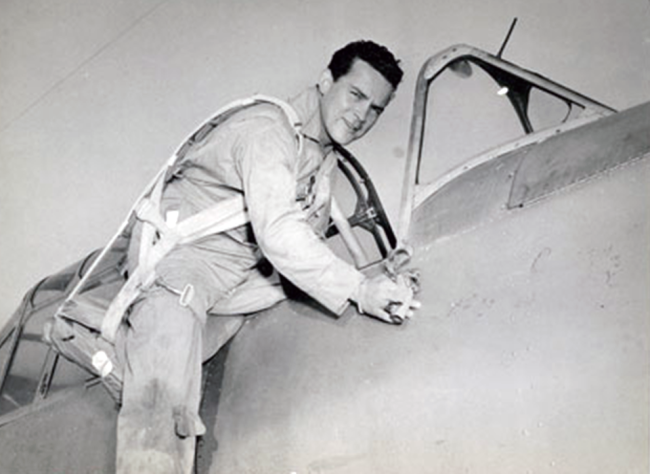Top image: Mustang fighters and utility aircraft, weather a hurricane stuffed into a hangar at Bartow Army Airfield, Florida in October of 1944. The National WWII Museum, Gift in Memory of Abraham and George Silver, 2015.301.043.
As World War II came to an end, the United States undeniably possessed the most formidable fighting force on Earth—able to confront any other military threat in existence. But even with expansive fleets of fighting aircraft and ships, and ranks of troops, trucks, and tanks, and even the emerging know-how to harness the power of the atom, America’s war machine always took a back seat to the worldly constant of the power of nature. America’s war machine was consistently challenged by unpredictable weather and the dangers posed by the natural world.
Rough weather, of course, heavily defined the World War II efforts in the Aleutians, the North Atlantic, and on the Eastern Front. More peculiar and precise were the strange natural events of 1944 and 1945 in every theater of war.
On January 25, 1944, Marine fighter squadron VMF-422 took off from Tarawa headed for Funafuti. During the first leg of their journey, the 23 fighter pilots encountered a wall of angry gray clouds stretching to 30,000 feet. They tried to thread the needle, squeaking their Corsairs into the tight space at the bottom of the storm, just a few feet above terrifying 50-foot swells and wind-blown spray. With their radios and instruments crippled by the power of the electrically-charged tempest, they were soon lost.
Some pilots became separated from the group. Marine pilot John Hansen was the luckiest, the only member of VMF-422 to land his fighter at Funafuti. Back in the main group, Lieutenant Chris Lausen reported engine trouble and had to ditch among the swells. When fuel ran low, the remaining fliers ended up in the sea. In one afternoon, VMF-422 was completely wiped out. Six pilots were never seen again.

In the shadow of Mount Vesuvius, the wreckage of a charred 340th Bombardment Group B-25 Mitchell lies in the ashes of Pompeii Airfield. Courtesy National Archives.
A world away, amid the heavy fighting in Italy, Mount Vesuvius coughed to life. The most immediate victims of the March 23 plume of super-heated ash was a B-25 bomber outfit based at Pompeii Airfield at the base of the volcano. Though the men of the 340th Bombardment Group evacuated and suffered no casualties, their compliment of bombers was demolished. The unit lost upwards of 88 aircraft when the eruption sprayed out tons of hot ash and rock fragments onto the parked planes, burning control surfaces, devouring delicate engine components, and roasting Plexiglas windows and turrets. Sergeant Robert F. McRae wrote in his diary, “Upon reaching the airport on the 26th we found almost complete devastation. Tents were torn to ribbons and 88 airplanes were a total loss … $25,000,000 worth of aircraft. How Jerry gloated.”
Later that year, Germany launched one last offensive in the West. Part of their initial success can be attributed to the heavy overcast that blanketed the Ardennes region, grounding the Allies’ potent air forces. When reconnaissance missions slackened, and US fighter-bombers stayed on the ground, Hitler’s forces took advantage. What would be later known as the Battle of the Bulge, which began on December 16, 1944, turned quickly in favor of the Allies when the skies cleared and reinforcements appeared, allowing US and British aviators to again bestride the battlefield.
As the German offensive jumped off in Europe, there was a storm brewing in the Pacific. Yet Admiral “Bull” Halsey chose to keep Task Force 38 on station in the Philippine Sea rather than making way for a powerful tropical cyclone. “Typhoon Cobra” slammed into the ships. On December 18, 1944, three US destroyers capsized and sank in heavy seas. Carriers rolled sickeningly, as aircraft, spare engines, and onboard equipment slid and tumbled like wrecking balls in hangar decks, starting fires and ripping into sprinkler pipes. Topside, 100-knot winds tore away radar antenna, radio masts, and in one rare case, a stout 20mm gun sponson.
When it was over, 790 US servicemen were lost, dozens of combat ships suffered damage, and 146 relatively delicate aircraft were crushed, mangled, or simply torn free and tumbled overboard. Perhaps Japan’s mythical divine wind had returned, and yet it failed to fully stop the US Navy.
![Crews inspect the mangled remains of a TBM Avenger on the deck of the USS Hornet [ITALICS] (CV-12) after Hurricane Cobra swept through in 1944. The National WWII Museum, Gift of Nap Pozulp, Ph.D., 2018.067.798.](/sites/default/files/styles/wide_large/public/2022-05/nature-vs-military-Photo-Two-Cory-Graff.jpg?h=5c654017)
Crews inspect the mangled remains of a TBM Avenger on the deck of the USS Hornet (CV-12) after Hurricane Cobra swept through in 1944. The National WWII Museum, Gift of Nap Pozulp, Ph.D., 2018.067.798.
Strangely, Halsey and an element of the Third Fleet were pulled into a painful rematch in June of 1945. Typhoon Connie, not nearly as deadly as Cobra, killed seven US sailors and wrecked 100 more aircraft. Struggling in mountainous waves, the heavy cruiser USS Pittsburgh (CA-72) completely lost 110 feet of her bow. The carriers USS Hornet (CV-12) and USS Bennington (CV-20) had the forward 24 feet of their flight decks crumpled by the weight of tons of seawater.
![The cantilevered flight decks of aircraft carriers like the USS Wasp [ITALICS] (CV-18) were known to collapse under the weight of mountainous waves. Courtesy National Archives.](/themes/nwwiim/images/loaders/placeholder.gif)
The cantilevered flight decks of aircraft carriers like the USS Wasp (CV-18) were known to collapse under the weight of mountainous waves. Courtesy National Archives.
Navy ships and sailors were not the storm’s only victims. Days before, when Connie was still a tropical depression, a huge formation of P-51 Mustang fighters stumbled into its path. The island airbase of Iwo Jima launched 148 fighters on the morning of June 1, 1945 along with several B-29s to aid them with navigation on the long flight to targets in Japan. Along the way they encountered a black wall of cumulonimbus soaring into the heavens.
The B-29 crews, decidedly more comfortable in their big, four engine behemoths, attempted to lead the smaller fighter planes though an open “canyon” between towering walls of clouds. And then the walls closed in. The Mustang pilots tightened their formations and plunged into darkness.
In the bumping, broiling belly of the storm, one formation crossed another, as fighter planes skidded, climbed, dove, and rolled to escape brief flashes of other American aircraft boring in on them through the gloom. In quick moments of clear skies, terrified fliers saw parachutes and fragments of Mustangs fluttering toward a windswept sea far below.
Only a handful of fighters made it to their targets near Osaka, Japan. Most turned back. Three men who went down survived “Black Friday” to fly another day. Lt. Lawrence Grennan nearly made it back to base, bailing out just ten miles from Iwo Jima. Lt. Thomas Harrigan was spotted by a PBY and picked up by a ship after two days at sea. Lieutenant Arthur A. Burry bailed out of his aircraft and rode out Typhoon Connie in a tiny raft, alone. He was miraculously located by the submarine USS Trutta (SS-421) after seven days adrift. Another 24 Mustang pilots were never heard from again.
On one of the last days of war, weather played a factor. Following the atomic bombing of Hiroshima, another B-29 was headed to Japan with a second bomb on August 9, 1945. The weather over the primary target was poor, obscured by clouds as well as the smoke from previous American attacks. As a result, the B-29 lugging the atomic bomb nicknamed “Fat Man” left the city of Kokura undisturbed and motored southwest. At 11:02 local time, that second bomb detonated 1,650 feet above the city of Nagasaki.
Though Italy, Germany, and finally Japan met defeat, Mother Nature raged on. Just days before formal surrender ceremonies in Tokyo Bay, Typhoon Helen, a category three, smashed the bow of the USS Wasp (CV-18). The carrier continued to launch aircraft on patrols despite losing the forward 30 feet of her flight deck. The next storm, a category two dubbed Typhoon Ursula, rolled through a week later. It brought down six cargo aircraft transporting POWs from Okinawa to Manila. Heartbreakingly, over 120 servicemen lost their lives.

Combat pilot Jack Wilson spent nearly the entire war in the Pacific. Wilson and his crew were lost when their plane went down in Typhoon Ursula in the Philippine Sea, weeks after Japan’s surrender. The National WWII Museum, Gift in memory of Col. Jack A. Wilson, 2016.087.
The war with the natural world continues undeclared, even in the 21st century. “Heavy, lashing rains” on Guam resulted in the loss of a B-2 bomber in 2008 when moisture entered its air-data sensors, causing a costly crash. In 2018, Hurricane Michael hit Tyndall Air Force Base causing damage to 17 Lockheed Martin F-22 fighters left on-site. Repairs cost $6 billion. A year later, the swollen Missouri River flooded into Offutt Air Force Base, causing $420 million in damages.

At a US Navy airfield in Florida, World War II vintage SNJ trainers are lashed to the tarmac on their bellies as a hurricane comes ashore in 1962. Courtesy National Naval Aviation Museum.
Using men, machines, and mettle, the US military always moves forward, but with the knowledge they can never conquer Mother Nature. They can only hope to endure.
Cite this article:
MLA Citation:
APA Citation:
Chicago Style Citation:









